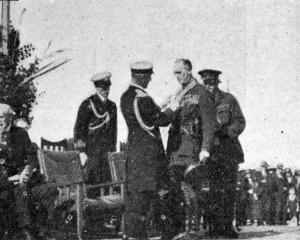Messrs H. P. Barry and M. F. Haszard concluded a successful fishing day by hooking on (using a shark line) an unusually big shark off Kauri Point.
They were prepared for such an event, and quickly had the anchor up, and soon after the shark had the launch in tow.
Eventually the monster broke away.
Early next morning the same party, with the sole object of hunting sharks, started off in their launch for Kauri Point.
They trailed a five-foot shark in the water in the hope of being able to entice other sharks close enough to the boat to be within striking distance of the harpoon.
However, one big chap was too wily for them, and before they could pull the trailed shark near to the boat it was snapped with almost startling swiftness, and bitten clean in two, leaving but a portion of the shark on the rope.
Later a shark was hooked, and for over an hour the launch was towed about.
Sometimes the shark would take a straight course for half a mile.
Ultimately it was despatched.
While its length was only 7 feet 9 inches, its girth was tremendous, and it weighed over 3cwt.
Its jaws in extension measured 9 inches.
• Sixty-four days out from the Puget Sound with a cargo of timber, the American schooner C. S. Holmes, 376 tons, "picked up'' Mount Egmont at sunrise on Saturday morning, and reached New Plymouth that evening.
The vessel is in charge of Captain John Backland (who is also the owner), and he is accompanied by his wife, his son, and his daughter.
In the past year or two (says the Taranaki Daily News) several sailing ships have arrived at New Plymouth from Puget Sound, and the C. S. Holmes, in making the passage in 64 days, has beaten her rivals for speed.
The Eric took 74 days, and the H. D. Bendixsen, on two trips, took 88 days and 90 days.
It is 20 years since the C. S. Holmes was launched, and the greater part of her career has been spent in the Pacific Coast trade.
In the last few years, however, the schooner and her captain have been engaged in venturesome journeys to the extreme north of Alaska.
"I have had nothing but ice and Eskimos on my voyages for the last year or two, so I thought I would take on this stunt down here to see if the sun was still shining in the south,'' remarked Captain Backland.
On her trips to the north the schooner took supplies for the Eskimos and various stations in the north, and exchanged her cargo for furs, whalebone, ivory, etc.
• Sir, - Now that a number of farm labourers and farmers' sons have gone to war, the farmers are being pestered to death with Government inspectors and threatened with prosecution if all Californian thistles are not cut immediately.
In the first place, how is this to be done, especially in rough country, when no extra labour can be obtained and a good few farmers' sons are away?
One case in point.
A farmer's only son is away, and his father is left on the place alone.
Just to make himself known, the inspector sent this old man notice to clear his thistles.
This is unjust.
The Government wants recruits from the country, and then does not study the old people that are left.
What should be done is either to wipe the Act off the Statute Book or prosecute every landholder in the district.
It would be a fortunate thing if several of the inspectors were to volunteer for active service instead of riding along the roads, looking over fences, and saying, "I inspected so-and-so on such a date.'' - I am, etc., Warepa. January 14. - ODT, 17.1.1916.












